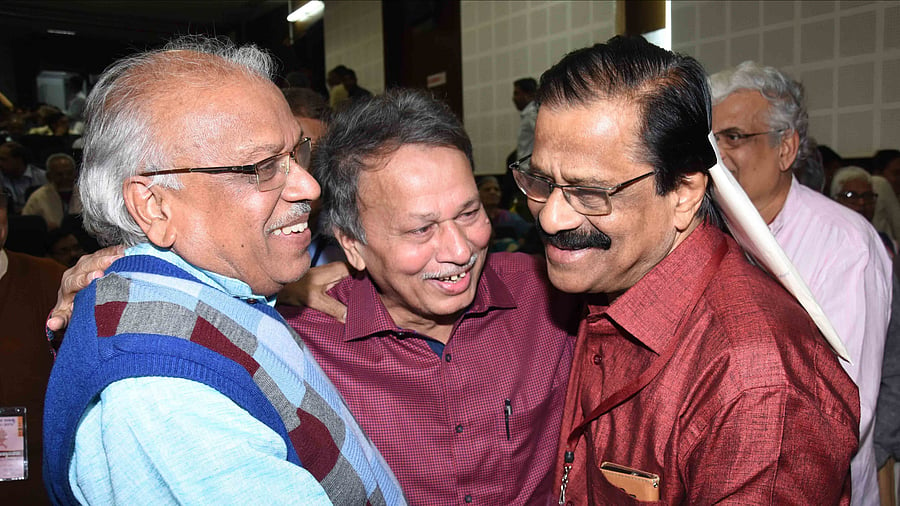
Credit: Special arrangemetn
Eminent Kannada poet H S Venkatesh Murthy (June 23, 1944-May 30, 2025), fondly called HSV, is no more. With his passing, our living link to a long and luminous tradition — from Kumaravyasa, Pampa, and Ranna to Adiga, Bendre, and Janakamma — has become weaker.
A strong connection to the grand tradition of Kannada literature, embodying and celebrating it every moment of his life, this mild-mannered, true-blue poet lived as if the great poets had been bequeathed to him (Pithrarjitha) and his most sacred responsibility was to make this inheritance his Nityakarma, his everyday routine.
The great poets had to be not just read, but had to be engaged as in a Paaraayana, the way it is with Shruti and Smriti texts. “Won’t my grandfather ask me from the high heavens, ‘I have left my property for you, hope you are safeguarding it…,” HSV would say, reiterating that the legacy had to be earned (Svayaarjitha), preserved and continued.
Likening the Kannada Kavya tradition to an ocean, he said that poets who respond to this tradition from the present are like waves, ‘a new Raga added to ancient music’.
His contributions in the present were also holding a mirror to the past, resonating with T S Eliot’s “Time present and time past/Are both perhaps present in time future/And time future contained in time past.”
His favourite example to illustrate the point was to say, “It is like Pampa looking into the mirror today and giving himself a new hairstyle!”
The past, therefore, had to be continually reorganised and was never something that was over for him.
In HSV’s poetry, you can see traces of two entirely different sensibilities — the pre-Navya and post-Navya. The Bhaamini Shatpadi pattern of the old Kannada writing came as naturally to him (“Kenchideviyu poreyelellara”) as does a starkly modern style (“Soudhagrahagalu sididu, dhoolu meleelutta / baana gummatavanne aavarisuttide, aaha! aa mahaa maaranada agnisthamba”).
On his grand canvas, there are Pampa, Ranna, Kumaravyasa, along with Putina, Masti, Bendre, and the consciousness of Adiga, Ananthamurthy, and Lankesh. Do the trees ever ask themselves questions like “Must we flower? Bear fruit? Will there be takers?” (“Baaro, Baaro MaLerAya”). Using the tree as his central metaphor, bringing the philosophies of several other poets into his own, he described that the act of writing for a poet must be as natural as it is for a tree.
Shaping his viewpoint, he echoed Hopkins’ plea for ‘being’ – “Send my roots rain”, along with poet G S Shivarudrappa’s “Haaduvudu anivaarya, karma nanage”, the inevitability of ‘doing’. He took his argument further by yoking together the acts of ‘being’ and ‘doing’ as they culminate in Basavanna’s “Kaayakave Kailasa”. If producing flowers, fruits and seeds is an organic, biological process for the tree, writing, like breathing, must be a natural state of existence for a writer, he insisted.
The deeply committed poet that he was, he believed in the continuity of tradition.
HSV was conscious of the dangers of Vismarane (forgetfulness) and wrote on Pampa, Kumaravyasa for children.
Language has to be reinvented for children –Sambhavami Yuge Yuge – it has to be like the teaser of a film, ‘they have to get hooked immediately’, he said.
“You cannot sit in your ivory tower and expect Bhuvaneshwari to sort it out,” he would say, remembering poet G P Rajaratham, the foot soldier of Kannada.
In his poem ‘Kaviyu Theerida Mele’ (After the poet passes away), he aspires for “Nettirulu yaavudo gaali beesuva ghalige/pustakada mai tumba bariya rekke” echoing Tagore’s “Let my words gain wings/ And let every tree in the forest break into green…”.
May HSV’s journey into higher freedom be as poetic as the life he lived — rooted in the past, vibrant in the present, and ever flowering into the |
future.
(The writer is a professor at RV University, Bengaluru)